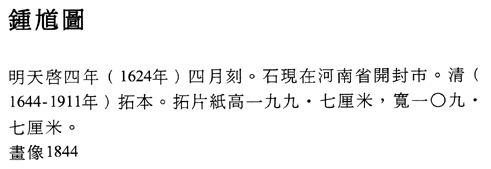 |
|
|
 |
|
|
Illustration of
Zhong Kui the Demon Queller Ming
dynasty (1368�1644), Tianqi period (1621�27) dated 1624 Unmounted
sheet comprising 3 joined sheets, ink rubbed on paper; 199.7 x 109.7 cm Date
of rubbing not given, Qing dynasty (1644�1911) Inventory number: Huaxiang 1844 Zhong
Kui is one the most popular folk icons of the Chinese.� According to legend sometime during the
Kaiyuan era (713�42) Emperor Xuanzong (685�762; r. 712�62) of the Tang fell ill
and had a nightmare in which he was disturbed by Xu Hao, a small demon of
destruction who stole his jade flute and his consort's perfume bag.� The little demon was subsequently captured
and devoured by another imposing demon dressed in ragged clothes and black
boots, who introduced himself to the emperor as Zhong Kui, a failed scholar who
had committed suicide a century earlier and appointed himself exorcist.� When the emperor awoke from his dream, he
commanded the court painter Wu Daozi (689�759) to paint a portrait of Zhong
Kui. This
portrait, engraved on a large stone stele, depicts Zhong Kui in the pose of a
warrior.� However, he carries a qin
(zither) and a case of books.� Based on
the title slip on the case, Jun tian guang yue, this picture may be
titled "Zhong Kui Listening to Heavenly Music."� The two-columned inscription at upper left
provides the name of Liang Jianting from Guanzhong (Shaanxi), a prefect in
Henan province, and an early summer date in the jiazi year of the Tianqi
reign era, i.e. 1624.� The other
inscription at the middle left states that Liu Anxing, the district magistrate
of Dengfeng County was responsible for erecting the stone engraving.� The original stone is now kept in the
Shaolin Temple at Dengfeng (Kaifeng) in Henan Province. |
 |